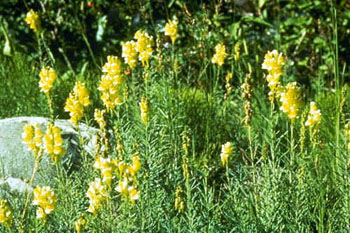Welcome Students!
When it comes to the environment, we tend to “sweat the big stuff” like massive forest fires, climate change, and pollution from factories. As we deal with these very visible issues, we sometime overlook the less obvious problems.
As we deal with these very visible issues, we sometime overlook the less obvious problems.
Invasive species are currently the second leading threat to biodiversity. Habitat destruction is the leading threat (http://www.actionbioscience.org/biodiversity/simberloff.html). However, unlike pollution and fires, invasive species do not generate much media attention.
This module focuses on invasive plant species. Throughout this module you will learn the ecology behind why invasive species can be so destructive. You will gain an understanding of how invasive plants spread, and you will be exposed to some of the methods of removing such plants.
Invasive plants is an issue of concern in the Upper South Platte Watershed. CUSP focuses on noxious weeds, one category of invasive plants. After completing this module, you will have the opportunity to participate in a service-learning day with CUSP staff in the watershed to remove noxious weeds. You will learn first-hand the challenges of removing invasives and the importance of preventing the establishment of invasives. The CUSP staff looks forward to working with you!
Sincerely,
Sarah Lykens
Outreach Assistant
Coalition for the Upper South Platte
http://cusp.ws
Student Information
The online pre-assessment can be accessed here. Your teacher will give you the access code and your log in name. Use the same log in name and get the access code from your teacher for the post-assessment at the end of the module found here.
Objectives and Education Standards
ACTIVITIES
Ecological Impacts Student Instructions
DOCUMENTS and MATERIALS
Background Information
Vocabulary
Plant Invasion Worksheet
Ecological Impacts Worksheet
Ecological Impacts Reading
Management Think Sheet
Control Methods Handout
Case Studies Summary
Mechanical Control
Chemical Control
Biological Control
Spotted Knapweed Study
Spotted Knapweed Management
Invasives and Economics Article
Herbicide Resistance Article
Mechanisms of Herbicide Resistance
LINKS
Bailey, Nikki. “Spotted Knapweed (Centaurea maculosa): A Study of the effects of a biological control agent by students from Fort Benton High School, MT.” Johnson, E. & Liebers, S. February 2003. Web. March 2012. http://mtwow.org/spotted-knapweed-Fort-Benton-student-study.htm.
Case Studies for Managing Invasive Plants. U.S. Department of the Interior: Bureau of Land Management. http://www.blm.gov/wo/st/en/prog/more/weeds/case_studies.print.html.
Early, David. “A Bear Trap Rite of Spring.” U.S. Department of the Interior: Bureau of Land Management, Dillion Field Office. March 2012. http://www.blm.gov/mt/st/en/info/newsroom/steward/08summer/beartrap.print.html
Early Detection & Distribution Mapping System. The University of Georgia – Center for Invasive Species and Ecosystem Health. (Interactive map.) http://www.eddmaps.org/tools/choosecounty.cfm.
Legner, E. Fred. Klamath Weed (=St. John’s Wort) Hypericum perforatum L. – Hypericaceae. University of California. http://faculty.ucr.edu/~legneref/biotact/ch-66.htm.
Penn State. “Integrated weed management best response to herbicide resistance.” ScienceDaily, 9 Feb. 2012. Web. March 2012. http://www.sciencedaily.com/releases/2012/02/120209135840.htm.
“Piedras Blancas Light Stations Outstanding Natural Area Native Plant Restoration.” U.S. Department of the Interior: Bureau of Land Management, Bakersfield Field Office. March 2012. http://www.blm.gov/ca/st/en/fo/bakersfield/Programs/pbls/plant_restoration.html.
Plants Database. Natural Resources Conservation Service. United States Department of Agriculture. http://plants.usda.gov/java/.
Species Management and Control Information: Spotted Knapweed Centaurea maculosa Larmarck or C. bierbersteinii DC. DCNR Invasive Exotic Plant Tutorial for Natural Lands Managers. March 2012. http://www.dcnr.state.pa.us/forestry/invasivetutorial/Spotted_knapweed_M_C.htm.
State Resources. National Invasive Species Information Center. United States Department of Agriculture National Agricultural Library. http://www.invasivespeciesinfo.gov/unitedstates/state.shtml.
Tharayil-Santhakumar, Nishanth. “Mechanisms of Herbicide Resistance in Weeds.” Plant & Soil Sciences. University of Massachusetts, Amherst, MA 01003. http://www.weedscience.org/paper/Mechanism%20of%20Herbicide%20resistance.PDF.
USDA/Agricultural Research Service. “Eliminating weeds could put more cows on the pasture.” ScienceDaily, 28 Apr. 2010. Web. March 2012. http://www.sciencedaily.com/releases/2010/04/100428121443.htm.
REFERENCES
C. E. Bell, J. M. DiTomaso, C. A. Wilen. “Invasive Plants.” UC IPM Online. 11/07. University of California Agriculture & Natural Resources. http://www.ipm.ucdavis.edu/PMG/PESTNOTES/pn74139.html.
Hall, M. “Ecological Impact of Invasive Plants” Brown University. Center for Environmental Studies. http://www.brown.edu/Research/EnvStudies_Theses/full9900/mhall/IPlants/Ecological_Impact.html.
Integrated Weed Management. CSIRO. http://www.csiro.au/Outcomes/Food-and-Agriculture/IWM.aspx.
Invasive Plants: Change in Fire Regime. National Invasive Species Information Center. http://alic.arid.arizona.edu/invasive/sub8/p3.shtml.
Invasive Plants: Methods of Control. National Invasive Species Information Center. http://alic.arid.arizona.edu/invasive/sub3/p7.shtml.
Simberloff, Daniel. “Introduced Species: The Threat to Biodiversity & What Can be Done.” American Institute of Biological Sciences. 2000. http://www.actionbioscience.org/biodiversity/simberloff.html.
“Under/Out of Control.” Invasives: Plants on the Move. March 2012. http://www.weedinvasion.org/pdfs/Control/under_out_of_control.pdf.
United States. Definitions Subcommittee of the Invasive Species Advisory Committee. Invasive Species Definition Clarification and Guidance White Paper. Approved April 27, 2006. http://www.invasivespeciesinfo.gov/docs/council/isacdef.pdf.
United States. Federal Noxious Weed Act of 1974 (Summary). January 3, 1975 as amended 1988 and 1994. http://www.thecre.com/fedlaw/legal2/fedweed.htm.
“Weed Invasion.” Invasives: Plants on the Move. March 2012. www.weedinvasion.org.
What is Integrated Weed Management? Minnesota Department of Agriculture. http://www.mda.state.mn.us/plants/pestmanagement/weedcontrol/whatisiwm.aspx.
ADDITIONAL RESOURCES
Center for Invasive Plant Management. 2012. Department of Land Resources of Environmental Sciences, Montana State University, Bozeman, MT. March 2012. http://www.weedcenter.org/.
Invasive Plants. August 2008. The United States National Arboretum. March 2012. http://www.usna.usda.gov/Gardens/invasives.html.
Plants Database. Natural Resources Conservation Service. United States Department of Agriculture. http://plants.usda.gov/java/.
State Resources. National Invasive Species Information Center. United States Department of Agriculture National Agricultural Library. http://www.invasivespeciesinfo.gov/unitedstates/state.shtml.
Volunteers and Invasive Plants: Learning and Lending a Hand. 21 August 2008. U.S. Fish and Wildlife Service National Wildlife Refuge System. http://www.fws.gov/invasives/volunteersTrainingModule/bigpicture/invasives.html.
“Weeds Affect Millions of Acres of Public Lands.” 25 August 2011. U.S. Department of the Interior: Bureau of Land Management. March 2012. http://www.blm.gov/wo/st/en/prog/more/weeds.html.